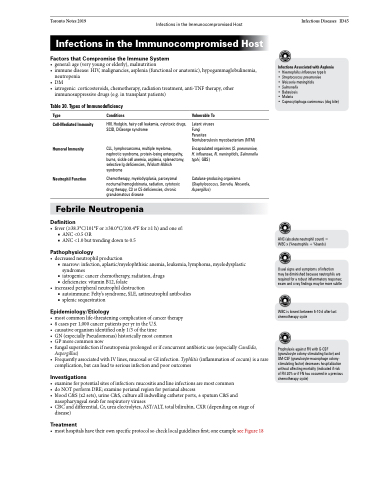Page 645 - TNFlipTest
P. 645
Toronto Notes 2019 Infections in the Immunocompromised Host Infections in the Immunocompromised Host
Factors that Compromise the Immune System
• general:age(veryyoungorelderly),malnutrition
• immunedisease:HIV,malignancies,asplenia(functionaloranatomic),hypogammaglobulinemia,
neutropenia
• DM
• iatrogenic:corticosteroids,chemotherapy,radiationtreatment,anti-TNFtherapy,other immunosuppressive drugs (e.g. in transplant patients)
Infectious Diseases ID45
Infections Associated with Asplenia
• Haemophilus influenzae type b • Streptococcus pneumoniae
• Neisseria meningitidis
• Salmonella
• Babesiosis
• Malaria
• Capnocytophaga canimorsus (dog bite)
Table 30. Types of Immunodeficiency
Type
Cell-Mediated Immunity
Humoral Immunity
Neutrophil Function
Conditions
HIV, Hodgkin, hairy cell leukemia, cytotoxic drugs, SCID, DiGeorge syndrome
CLL, lymphosarcoma, multiple myeloma, nephrotic syndrome, protein-losing enteropathy, burns, sickle cell anemia, asplenia, splenectomy, selective Ig deficiencies, Wiskott-Aldrich syndrome
Chemotherapy, myelodysplasia, paroxysmal nocturnal hemoglobinuria, radiation, cytotoxic drug therapy, C3 or C5 deficiencies, chronic granulomatous disease
Vulnerable To
Latent viruses
Fungi
Parasites
Nontuberculosis mycobacterium (NTM)
Encapsulated organisms (S. pneumoniae, H. influenzae, N. meningitidis, Salmonella typhi, GBS)
Catalase-producing organisms (Staphylococcus, Serratia, Nocardia, Aspergillus)
Febrile Neutropenia
Definition
• fever(≥38.3°C/101°For≥38.0°C/100.4°Ffor≥1h)andoneof: ■ ANC<0.5OR
■ ANC <1.0 but trending down to 0.5
Pathophysiology
ANC (absolute neutrophil count) = WBC x (%neutrophils + %bands)
Usual signs and symptoms of infection
may be diminished because neutrophils are required for a robust inflammatory response; exam and x-ray findings may be more subtle
WBC is lowest between 5-10 d after last chemotherapy cycle
Prophylaxis against FN with G-CSF (granulocyte colony-stimulating factor) and GM-CSF (granulocyte-macrophage colony- stimulating factor) decreases hospitalization without affecting mortality (indicated if risk of FN 20% or if FN has occurred in a previous chemotherapy cycle)
• decreasedneutrophilproduction
■ marrow: infection, aplastic/myelophthisic anemia, leukemia, lymphoma, myelodysplastic
syndromes
■ iatrogenic: cancer chemotherapy, radiation, drugs ■ deficiencies: vitamin B12, folate
• increasedperipheralneutrophildestruction
■ autoimmune: Felty’s syndrome, SLE, antineutrophil antibodies ■ splenic sequestration
Epidemiology/Etiology
• mostcommonlife-threateningcomplicationofcancertherapy • 8casesper1,000cancerpatientsperyrintheU.S.
• causativeorganismidentifiedonly1/3ofthetime
• GN(especiallyPseudomonas)historicallymostcommon
• GPmorecommonnow
• fungalsuperinfectionifneutropeniaprolongedorifconcurrentantibioticuse(especiallyCandida,
Aspergillus)
• FrequentlyassociatedwithIVlines,mucosalorGIinfection.Typhlitis(inflammationofcecum)isarare
complication, but can lead to serious infection and poor outcomes
Investigations
• examineforpotentialsitesofinfection:mucositisandlineinfectionsaremostcommon
• doNOTperformDRE;examineperianalregionforperianalabscess
• bloodC&S(x2sets),urineC&S,cultureallindwellingcatheterports,±sputumC&Sand
nasopharyngeal swab for respiratory viruses
• CBCanddifferential,Cr,ureaelectrolytes,AST/ALT,totalbilirubin,CXR(dependingonstageof
disease)
Treatment
• mosthospitalshavetheirownspecificprotocolsochecklocalguidelinesfirst;oneexampleseeFigure18


